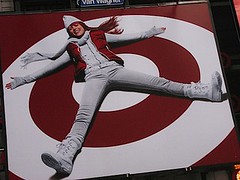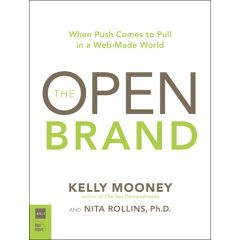“For the first time in the history of calculating the ROI of marketing expenditures, influence behaviors and patterns of the volume achievable only on the social web begin to offset the overall cost of marketing,†quotes the new book “The Open Brand: When Push Comes to Pull in a Web-Made World†by Resource Interactive’s President Kelly Mooney and Innovation Consultant Dr. Nita Rollins.
While not appearing on page one, this idea is certainly one of the most important, and likely most sought after skim through takeaways marketers (both on the client and agency side) will seek when first hunting for the knowledge contained within this book.
Mooney’s book reinforces what many savvy marketers have known for years – that “cutting edge†will become increasingly synonymous with an embrace of the openness of the oceanic global marketplace – strategically riding the waves, rather than trying to overbearingly control them – and that this adaptation will be the strongest influence on marketing ROI.
The book begins with an excellent chart dispelling some long held notions of what companies have over the years been taught to believe, along with a non-condescendingly flipside, for example:
Do You Believe: Brand managers own and orchestrate their own brand
Or Do You Believe: Consumers co-create brands?
Do You Believe: Online chatter is white noise
Or Do You Believe: Consumer online chatter is a crystal ball, R&D lab and sounding board?
For those marketers and brands behind the times, now is the time to adjust your world view and, if necessary, position yourself as one of the elite “hip†who have always been on the “Or Do You Believe?†side of the equation as one of the first to recognize the benefiting effect of early adaptation.
The book solidifies its core concepts by redefining the word “open”, by way of acronym “O.P.E.N.” “Openâ€, a word long identifiable in the brick and mortar world with a sign indicating a purveyor was ready for business, has now taken on a completely different definition as our market has entered a phase where consumers expect to receieve what they want, when they want it, and always exactly how they like it:
O: On-Demand
P: Personal
E: Engaging
N: Networked
Educatory concepts are nothing to we marketers of course, without the real-world tales to back them up.
For anyone who skips ahead to the case studies, there are several to choose from:
- In 1997, a full decade before everyone seemed to start doing it, Burton Snowboards allowed users to share their own photos and stories on their website. This initiative offered a dialogue from existing customers, and in effect, extremely low-cost market research into the turn-ons of their core customers.
- In 1999, Victoria’s Secret promoted a then revolutionary online fashion show during the half-time of the Super Bowl, drawing over 1.5 million viewers away from the typical halftime extravaganzas and launching their brand recognition into the stratosphere.
- Consumer created content, including recent Super Bowl ads by Chevrolet and Doritos, have been shown to shave nearly off roughly 75 percent of the typical 200K budget of commercial creation – a quantifiable dollar amount can be directly redistributed to a firm’s overall marketing, R&D, or product development budget.
In the face of the evidence provided above, and even more overwhelmingly so in this book that the OPEN movement is more reality than fad, and that a proper understanding of this new movement will actually lead to increased marketing ROI and decreased marketing costs, why does the book also point out resistance?
Blame the word “hipâ€. This word was not chosen earlier lightly. It is a word as likely to turn off a traditional, (ie “popular”) marketer as the phrase “ROI†is to turn them on. And if it’s one thing all the popular kids secretly hate, it’s the hip kids.
To play off a high school analogy, an “in-reverse†take on Robert Fulghum’s time-honored book “All I Need to Know I Learned in Kindergarten†(where everything we need to know become good and upstanding individuals is learned in this formative semi-grade) let’s begin a new book to help illustrate this titled, “All I Need to Know About Being A Jerk I Learned in High School.â€
For example:
- Reject all but necessary contact with those deemed as unpopular
On Joseph Jaffe’s excellent site Jaffe Juice, he reprints an email response from Target Corporation to a blogger who had contacted the behemoth in response to a complaint over an ad that, at its best, could be seen as “a tad bit suggestiveâ€.

The phenomenal response to this blogger, as printed below read:
Good Morning Amy, Thank you for contacting Target; unfortunately we are unable to respond to your inquiry because Target does not participate with non-traditional media outlets. This practice is in place to allow us to focus on publications that reach our core guest. Once again thank you for your interest, and have a nice day.
Now, before I sported the coolest ever pair of Ray-Bans seen in my photo above, it was not uncommon for me to be rejected by the opposite sex, especially in high school time and time again. Shocking, I know.
The tone of Target’s response, and the consideration that their HQ is just down the street, makes me think I’ve probably met the girl behind the response.
- Always charge your friends for favors
Remember that friend of yours, probably the first to have a car, who would charge you gas money for a ride to school despite the fact that you you lived on the way and their sweet ride consistently smelled of gasoline and Cheetos, and you risked exposure to the dangerous Eubola Virus just by wiping off the seat?I think of this every time NBC, and parent company GE, insist I pay for a formerly free Will Ferrell as Neil Diamond sketch that they cruelly neglected to include on Best of Will Ferell Volumes 1 or 2.
- Conversations are hard. Why bother trying?
On several episodes of Family Guy, teenager Chris Griffin is shown to have an awkward, at best, command of conversational etiquette, particularly as it relates to communications with the opposite sex.On the most recent episode, he received the regrettable advice from the old-guard, father Peter Griffin, that if he truly wanted to succeed at impressing women – the key was to pretend to be the biggest jerk possible.Even more regrettably, nearly every shy high school male has at one time or another fallen into this trap, and those that have had better hope they drive a nice car. In today’s high-speed, transparent marketplace, conversations must be honest, unique, and as the title of the book suggests – open. “Flogsâ€, or fake manufactured blogs whereby a company purports to support open conversation while the entire time actually manufacturing their own version of one they control, will be gleefully shot down by vigilant blogger watchdogs who simply have no more patience for the phoniness.
- If you believe it hard enough, it must be true
In David Lynch’s film “Lost Highway†[SPOILER ALERT…For any of those who can figure out Lynch films upon first viewings] Bill Pullman plays a man so convinced that he did not murder his wife, he shapes a completely different reality so seemingly non-sensical that your brain will hurt for days afterwords.Like Pullman’s character, like overly popular high schoolers, like large behemoth brands, in the end, some just don’t get it. Those who rein supreme cannot envision a time where they will not be on top, and will shape any future realities they envision around this singular idea.
Luckily, the book ends with a road map towards changed behavior, fittingly titled “The Rules of the Open Road.â€
After all, anyone can change their view of the world or market – and once accomplished – not a one of these concepts will be difficult to implement.
By reading and adhering to the lessons of The Open Brand (and exploring each and every one of the 45 pop culture references above) marketers are well on their way to successfully navigating this path.



